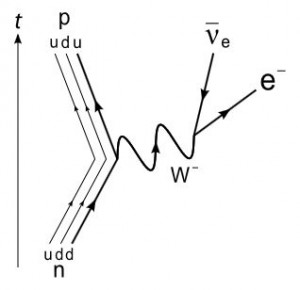
Is the neutron a stable particle?
The simple answer is Yes and No. The electrically neutral neutron, when inside the nucleus of an atom, is stable—indefinitely so.
A free neutron, however, is surprisingly unstable, with a half-life of only approximately ten minutes.
Does the Neutron Quark Up?
The current model of a neutron is that it is made up of three quarks—two down, one up. By down and up is meant “flavor.” Flavor is another term for variety of quark. There are six such varieties. The ordinary and lighter versions are “up” and “down.” Quarks have not been observed independent of the particles they purportedly make up.
When a free neutron decays, ordinarily one of the down quarks becomes an up quark, changing the neutron into a proton, with the emission of a W boson. This W boson, in turn, becomes an electron plus an anti-neutrino.
The change from two down quarks and one up quark in the neutron to one down quark and two up quarks for the proton balances electrically, since the down quark has a charge equal to -1/3. An up quark has a charge equal to +2/3. The change gives charge
- 2(-1/3) + 1(2/3) = 0 (neutron)
- 1(-1/3) + 2(2/3) = +1 (proton)
So the old model of a neutron being a composite particle consisting solely of a proton and an electron is not completely accurate.
Note: You might also enjoy Total Energy in One Hydrogen Atom
References:

So what is the conclusion? Is a free neutron a stable particle according to the current concept?
If you reread the article, you will see the answer is it has a half-life. Hence, a neutron is not truly stable.